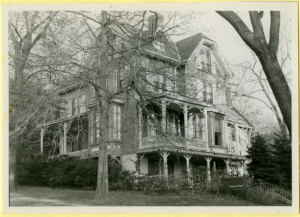Chatham unveils new exhibit on authenticity in African art
A collection of African figures and masks in the exhibit on Tuesday, Feb. 14. Photo credit: Megan Poff
February 20, 2023
A new exhibit, “Contradictions and Conundrums: Authenticity and African Art,” has opened in Chatham University’s Susan Bergman Gurrentz ‘56 Art Gallery in Woodland Hall. The exhibit features pieces from Chatham’s private collection of African art and aims to challenge notions of authenticity, beauty and primitivism. It is open from 11 a.m. to 7 p.m. on weekdays and closes Feb. 24.
Masks and figures make up the bulk of the exhibit, accompanied by labels that describe the object, its origin and how it relates to the various sections of the exhibit. Just a few examples of sections include “African Art in Transit,” “Art for the Market” and “Fakes.” It is the first large-scale showing of Chatham’s collection since 2018.
Dr. Elisabeth Roark, professor of art history and museum studies, said that the concern over authenticity in African art erases art made post-colonization.
“The traditional definition of authenticity was a work made by someone in the culture used by the culture, and ideally pre-colonial or not tainted by Western culture,” she said. “But that, scholars have subsequently realized, is a very limited view. It kind of freezes African art at a particular moment and doesn’t allow it to grow and change.”
Dr. Roark said that some of the objects in the exhibit were not typically desired by collectors in the past because they sought out pieces that they perceived as primitive, and those that were considered too beautiful weren’t seen as African art, leading to the “Too Beautiful” section of the exhibit.
“They’re beautifully proportioned, they usually have a beautiful shiny finish, they show exquisite carving and wonderful detail,” Dr. Roark said. “Those kinds of things were initially not considered typical of African art, which again, gives you a very limited perspective on what African art is when we’re talking about a continent filled with thousands of cultures that have very different objectives for their art.”
The exhibit was fashioned in Dr. Roark’s Curating African Art class last fall. Students Sully Pelles ‘25, Ava Meyers ‘22, Emily Wagner ‘22 and Yushi Zhang ‘23, led by Dr. Roark and assisted by other faculty members, selected and researched the art used in the exhibit and wrote the exhibition labels.
Zhang said she felt drawn to African art because it reminded her of misconceptions about China being a homogenous country.
“African art is a minority art. It’s pretty similar to my own personal identity as a minority group in China because people always think China is like, the whole thing is a board, everybody are the same people in China,” she said. “But actually, we do have like 46 minority groups. Each of us has a different identity and different art style, dress. We have our own history.”
Figuring out what African culture each piece of art came from was one of the difficulties for Zhang and the other students. Chatham’s collection of African art comes from Cheryl Olkes’ private collection that was gifted to the University in 2001 with almost no information on Olkes’ collecting practices and no record of the history of ownership.
“For one of the art objects that I was researching, it almost seemed like an auction website just kind of made something up,” Pelles, one of the students said. “It said that they were related to water divination … but there was no source anywhere for Tanzanian people doing anything related to water divination ceremonies, so they kind of just made that up and every other website just went with it. And that’s like the only information you can find about that object.”
Because the pieces are usually kept in a curating room, Dr. Roark hopes that students visiting the exhibit will leave with a new awareness of Chatham’s collection. A leak in the curating room resulted in a part of the art gallery being used as a storage space for additional African art pieces not included in the exhibit.
“It’s a very educational exhibition. It’s not just, I mean, you can certainly just enjoy the objects, but you’ll also learn a lot about African art and about some of these issues that museums and galleries struggle with in showing African art,” she said. “I hope that [visitors] will go off and tell people around Chatham that they should check the show out and see how wonderful the objects are.”








